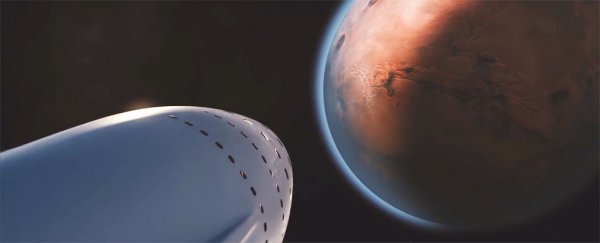It's a wildly ambitious plan, but SpaceX's Elon Musk says human passengers will be able to travel to Mars by 2025, thanks to the biggest rocket of all time.
Musk's grand vision, unveiled at a keynote address in Mexico on Tuesday, would see 100 passengers at a time ferried to Mars on an 80-day trip, aboard what he calls the Interplanetary Transport System.
Speaking at the International Astronautical Congress (IAC) in Guadalajara, Mexico, in what's been described as "the biggest speech of Elon Musk's career", the SpaceX chief said the Interplanetary Transport System (ITS) could begin flights as soon as 2023 – although he acknowledged that this was an optimistic timeline.
As the gorgeous SpaceX promo video below shows, the core of the ITS is a reusable booster rocket, which launches a passenger-carrying spaceship module into orbit. The booster rocket then separates from the module, returns to Earth, and picks up a propellant tanker.

It takes off again with the propellant tanker, meets up with the spaceship in orbit, and proceeds to fuel it. Once that's done, the booster and tanker again return to Earth's surface, and the fuelled-up spaceship module begins its 80-day sojourn to Mars, deploying a solar array to help it 'coast' on its way.
Tickets for this once-in-a-lifetime adventure might start as high as US$500,000 a pop at first, before dropping to perhaps around $100,000 over time, Musk said.
The biggest obstacle to pulling this off? The overall costs of developing the system, estimated by Musk to be in the vicinity of some $10 billion, and probably requiring a huge public-private-public partnership of sorts – as SpaceX's funding alone most likely wouldn't be sufficient to cover the tab.
"That is how the United States was established," Musk said, highlighting just how massive this project really is for him.
As a result of the money needed, the ITS overall is still mostly on the drawing board at this stage, but not everything about it is purely conceptual.
Over the weekend, SpaceX test-fired one of the Raptor rocket engines that would help launch the rocket and passenger module into space, and the company has also built a gigantic prototype fuel tank for the booster.
If all goes according to plan, the company intends to begin test flights with the ITS in four years – after it hopes to have sent an uncrewed Dragon capsule to Mars in 2018.
Although, there's an awful lot to build in the meantime. The ITS stands a staggering 122 metres tall, and the booster will be powered by 42 Raptor engines – the spaceship module itself will have nine.
Musk says the first ship in the series will be called the Heart of Gold, in homage to the spaceship in Douglas Adams' The Hitchhiker's Guide to the Galaxy.
But while SpaceX is getting started on the fundamental tech that could make this happen – money willing, that is – Musk's actual vision could take decades, even a century, to see to fruition.
While initial trips to Mars would only launch once every 26 months, the overall plan is to send thousands of these vessels to the red planet, establishing a self-sustaining Mars colony that could take between 40–100 years and some 10,000 flights to build.
Yes, it's crazily ambitious, but as Musk himself says, we're not going to get to Mars without dreaming big.
"I want to make Mars seem possible, something we can do in our life times… and that anyone can go if they wanted too," Musk said. "Without someone with a real ideological commitment, it didn't seem we were on any trajectory to become a spacefaring civilisation."
It's also possible that the Interplanetary Transport System – which until very recently was merely dubbed the Mars Colonial Transporter (MCT) – could take us places beyond the red planet, such as Europa, Jupiter's icy moon.
"This system really gives you freedom to go anywhere you want in the greater Solar System," Musk said.
But while the possibilities are almost limitless, some experts are dismissive of SpaceX's Mars vision and mission timeframes, saying the red planet dream amounts to a distraction from the business's real work: space haulage.
"It's unlikely that [Musk] will be able to get humans on Mars by 2025," former director of the Space Policy Institute at George Washington University John Logsdon told the AFP.
"Bottom line is the cost. You're talking of tens of billions of dollars and SpaceX doesn't have that type of money."
But for Musk, making it to Mars is personal, and despite dabbling in some other inconsequential business ventures – such as a little-known electric car company, home energy storage, and saving humanity from killer robots – getting off this planet is what he feels he was put on Earth to do.
"The reason I am personally accruing assets is to fund this," he said. "I really have no other purpose than to make life interplanetary."
